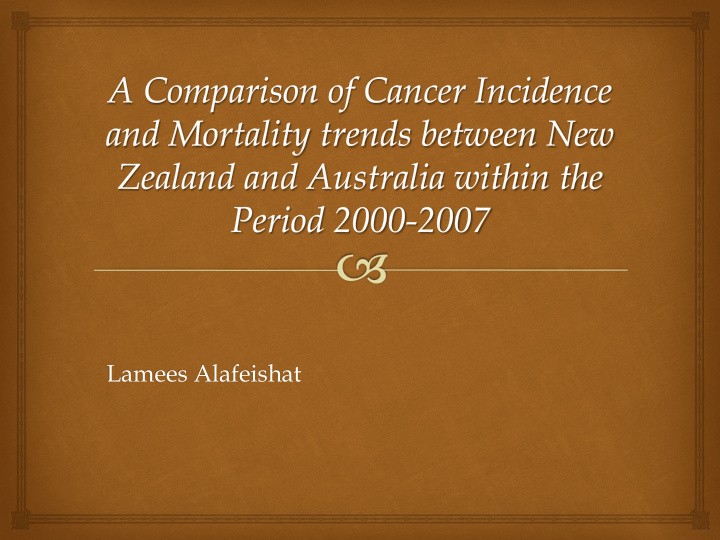



Lamees Alafeishat
Outline: Background and Rationale My Study Aims and Objectives Methods Results Conclusion Questions time
Why is it important do international comparisons of cancer incidence and mortality? The big killers? BECAUSE: Impact of Environment on cancer development Enhance knowledge about aetiology Prognosis of cancer and survival Impact of Policy, control and intervention programmes Who is in most need of urgent action and who is doing well The impact of new medical treatments and technology Evaluate systems performance And many more….
Cancer Incidence in 5 Continents International Union Against Cancer (UICC) and the World Health Organisation (WHO) First volume published 1966 (landmark in global cancer control) Stimulated research into social, environmental and systematic causes Since then there has been 9 publications, with the latest version published in 2009
Fast-forward in time… If mortality and incidence vary between countries, what about cancer outcomes in terms of survival, quality of life and patterns of care? Eurocare project (1995): Large international variations in cancer survival UK Cancer Plan 2000: Appointment of a National Cancer Director Cancer Reform Strategy 2007: Improve all areas of care from prevention and diagnosis to treatment and aftercare Concord and high-resolution studies
Key Points to Remember: Cancer Incidence in Five Continents set the scene for international comparisons of cancer incidence and mortality rates. Eurocare project as an example of a resulting research collaboration UK Cancer Plan 2000 and Cancer Reform Strategy 2007 On going work on cancer survival to investigate international differences (Concord) and drive further research into causes (high resolution studies)
Bringing it back to New Zealand and Australia Similar lifestyles, cultures, dietary behaviours and medical practices. Only one study compared the incidence and mortality between the two. Skegg and McCredie 2002 but looked at data from 1996 and 1997 Results showed higher mortality and incidence for males and females in NZ BUT there is potential for reducing the rates and closing the gab
Study Objectives Conduct an analysis of the differences in cancer incidence and mortality rates between NZ and Australia using more recent data from 2000-07 Fill in the current gab in knowledge about the differences in incidence and mortality between NZ and Australia Set the way for future research into cancer survival trends between the two countries and further investigations into causes of differences (if any)
Research Questions: Has the rates changed since the Skegg and McCredie study? Who is doing better and in what? What is the potential for reducing deaths from cancer in NZ What are the areas of priority for cancer research and public health action in NZ
Research Characteristics: Descriptive Epidemiology (what, who, where) Quantitative design Secondary data Age-standardisation All-cancers combined plus 5 cancer sites (lung, colorectal, pancreatic, female breast and prostate)
Methods: NZ population numbers extracted from Statistics NZ in 5-year age groups and by sex Australian incidence and mortality rates extracted from the Australian Institute of Health and Welfare Total cancer registrations and deaths for NZ extracted from the MOH Cancer New Registration and Deaths 2009 Report
Data analysis: Rates expected in New Zealand were calculated based on rates observed in Australian Total observed rate compared to total expected rate and standard incidence and mortality ratios calculated for each year and by sex Differences in number of cases calculated for each year and by sex Standard incidence and mortality ratios calculated for the entire period Excess/deficit numbers calculated for the entire period
Results: All-cancers combined
Colorectal Cancer
Lung Cancer
Pancreatic Cancer
Prostate Cancer
Female Breast Cancer
Summary of Key Results: There were small differences in incidence rates between Australia and NZ within the period 2000-07 for all-cancers combined, however, the mortality rates were significantly higher, for men and women, in NZ compared to Australia, suggesting poorer survival post diagnosis in NZ. If the Australian rates had applied, there would have been 2034 less deaths in males and 4747 less deaths in females across the period of 2000-07 Without accounting for the Australian rates, Lung cancer was the main cause of cancer deaths for men and women in New Zealand followed by Colorectal cancer, Female Breast cancer, Prostate Cancer and finally pancreatic cancer within 2000-07
Results cont. If we account for the Australian rates, the largest difference in mortality was caused by Colorectal cancer, followed by Female Breast, Lung and Prostate cancers over the period of 2000-07 suggesting poorer survival in that order Pancreatic cancer showed a negative mortality figure of 257, suggesting that mortality of Pancreatic cancer in New Zealand has been lower than that of Australia within 2000-07, hence survival is better in NZ for pancreatic cancer.
Conclusion: The differences in trends of mortality showed by Skegg and McCredie in 1996-97 remained in 2000-07 Although incidence of all-cancers are relatively similar, NZ is doing significantly worse than Australia in controlling cancer mortality Colorectal cancer is the top priority for NZ in terms of action to control mortality followed by Female Breast cancer
Future Research Investigate trends in cancer outcomes (survival and quality of life post diagnosis) Conduct high-resolution studies in order to understand and explain the difference in incidence and mortality rates between Australia and NZ Investigate and explain the factors that have allowed for lower mortality rates in Australia and advice policy and intervention programmes in NZ.
Limitations Accuracy of the results can be affected by the quality of data obtained from cancer registries Mortality data is affected by death certification processes and by accurate accounts of causes of death High incidence could reflect high screening and imaging techniques rather than true disease occurrence
Questions?
Recommend
More recommend